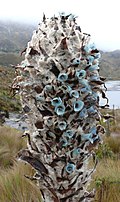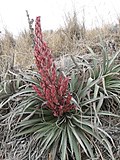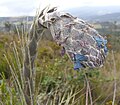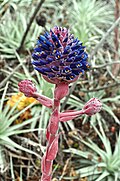| Subgenus | Image | Scientific name | Distribution |
|---|
| Puya |  | Puya alpestris (Poepp.) Gay | Chile |
|---|
| Puya × berteroniana Mez
( P. alpestris subsp. zoellneri × P. venusta ) | Chile |
 | Puya boliviensis Baker | Chile (Antofagasta) |
| Puya castellanosii L.B.Sm. | Argentina (Salta) |
 | Puya chilensis Molina | Chile |
 | Puya gilmartiniae G.S.Varad. & A.R.Flores | Chile (Coquimbo) |
 | Puya raimondii Harms | Bolivia and Peru |
| Puya weddelliana (Baker) Mez | Bolivia (Chuquisaca, Tarija) |
| Puyopsis(Baker) L.B. Sm. | | Puya adscendens L.B.Sm. | Peru |
|---|
| Puya aequatorialis André | Ecuador |
| Puya alata L.B.Sm. | Bolivia |
| Puya alba L.B.Sm. | Bolivia (Tarija) |
| Puya alpicola L.B.Sm. | Colombia (Sierra Nevada de Santa Marta) |
| Puya angelensis E.Gross & Rauh | Ecuador |
| Puya angulonis L.B.Sm. | Peru |
| Puya angusta L.B.Sm. | Peru |
| Puya antioquensis L.B.Sm. & Read | Colombia (Antioquia) |
| Puya araneosa L.B.Sm. | Peru. |
| Puya argentea L.B.Sm. | Peru (Ancash) |
| Puya aristeguietae L.B.Sm. | Venezuela |
 | Puya assurgens L.B.Sm. | Argentina (Jujuy) |
| Puya atra L.B.Sm. | Bolivia (Cochabamba) |
| Puya barkleyana L.B.Sm. | Colombia (Santander) |
| Puya bermejana S.E.Gómez, Slanis & A.Grau | Bolivia (Tarija) to Argentina (NW. Salta) |
 | Puya bicolor Mez | Colombia |
| Puya boopiensis R.Vásquez, Ibisch & R.Lara | Bolivia |
 | Puya boyacana Cuatrec. | Colombia (Boyacá |
| Puya brachystachya (Baker) Mez | Colombia (Sierra Nevada de Santa Marta) |
| Puya brackeana Manzan. & W.Till | Ecuador |
| Puya bravoi Aráoz & A.Grau | Argentina (Salta) |
| Puya brittoniana Baker | Bolivia (La Paz) |
| Puya cahuachensis A.Galán, J.Montoya, Vicente Orell. & E.Linares | Peru |
| Puya cajasensis Manzan. & W.Till | Ecuador |
| Puya cardenasii L.B.Sm. | Bolivia (Cochabamba) |
| Puya cardonae L.B.Sm. | Venezuela (Táchira) |
| Puya casmichensis L.B.Sm. | Peru (La Libertad) |
| Puya cerrateana L.B.Sm. | Peru |
 | Puya claudiae Ibisch, R.Vásquez & E.Gross | Bolivia |
 | Puya clava-herculis Mez & Sodiro | Colombia, Ecuador |
| Puya cleefii L.B.Sm. & Read | Colombia |
| Puya cochabambensis R.Vásquez & Ibisch | Bolivia |
 | Puya coerulea Lindl. | Chile |
| Puya colcaensis Treviño, Quip. & Gouda | Peru |
| Puya commixta L.B.Sm. | Peru (Puno) |
| Puya compacta L.B.Sm. | Ecuador |
| Puya coriacea L.B.Sm. | Peru (La Libertad) |
| Puya cristata L.B.Sm. | Bolivia (Cochabamba) |
| Puya cryptantha Cuatrec. | Colombia |
| Puya ctenorhyncha L.B.Sm. | Bolivia (La Paz) |
| Puya cuatrecasasii L.B.Sm. | Colombia |
| Puya cuevae Manzan. & W.Till | Ecuador |
| Puya cylindrica Mez | Peru |
 | Puya dasylirioides Standl. | Costa Rica |
| Puya densiflora Harms | Peru |
| Puya depauperata L.B.Sm. | Peru (Junín) |
| Puya dichroa L.B.Sm. & Read | Colombia |
| Puya dodsonii Manzan. & W.Till | Ecuador |
| Puya dolichostrobila Harms | Peru (La Libertad) |
| Puya donneriana R.Vásquez, Altam. & Ibisch | Bolivia |
 | Puya dyckioides (Baker) Mez | Argentina, Bolivia |
| Puya elviragrossiae R.Vásquez & Ibisch | Bolivia |
| Puya entre-riosensis Ibisch & E.Gross | Bolivia |
| Puya erlenbachiana Ibisch & R.Vásquez | Bolivia (Tarija) |
 | Puya eryngioides André | Ecuador |
| Puya exigua Mez | Ecuador (Azuay) |
| Puya exuta L.B.Sm. & Read | Columbia |
| Puya fastuosa Mez | Peru (Cajamarca) |
| Puya ferox Mez | Peru (Puno) |
| Puya ferreyrae L.B.Sm. | Peru (La Libertad) |
 | Puya ferruginea (Ruiz & Pav.)L.B.Sm. | Bolivia, Ecuador, Peru |
 | Puya fiebrigii Mez | Bolivia |
| Puya floccosa (Linden) É.Morren ex Mez | Brazil, Colombia, Costa Rica, Venezuela |
| Puya fosteriana L.B.Sm. | Bolivia (La Paz) |
| Puya fulgens L.B.Sm. | Peru (Amazonas) |
| Puya furfuracea (Willd.)L.B.Sm. | Colombia (Valle del Cauca) |
| Puya gargantae L.B.Sm. | Colombia (Norte de Santander) |
| Puya gerd-muelleri W.Weber | Peru (Cajamarca) |
| Puya gerdae W.Weber | Peru (Lima) |
| Puya gigas André | Colombia |
 | Puya glabrescens L.B.Sm. | Bolivia (Cochabamba) |
| Puya glandulosa L.B.Sm. | Peru (La Libertad) |
| Puya glareosa L.B.Sm. | Bolivia (La Paz) |
| Puya glaucovirens Mez | Peru |
| Puya glomerifera Mez & Sodiro | Ecuador |
 | Puya goudotiana Mez | Colombia |
| Puya gracilis L.B.Sm. | Peru |
 | Puya grafii Rauh | Venezuela (Amazonas) |
| Puya grandidens Mez | Peru (Ancash) |
| Puya grantii L.B.Sm. | Colombia |
| Puya grubbii L.B.Sm. | Colombia (Boyacá) |
| Puya guaramacalana Stergios, Caracas, Dorr & S.M.Niño | Venezuela (Trujillo) |
| Puya gutteana W.Weber | Peru (Cusco) |
 | Puya hamata L.B.Sm. | Colombia, Ecuador, Peru |
| Puya harmsii (A.Cast.) A.Cast. | Argentina |
| Puya harry-lutheri Gouda | Venezuela |
| Puya herrerae Harms | Peru |
 | Puya herzogii Wittm. | Bolivia (Cochabamba) |
| Puya hirtzii Manzan. & W.Till | Ecuador |
| Puya hofstenii Mez | Bolivia to Argentina (Jujuy) |
| Puya horrida L.B.Sm. & Read | Colombia |
| Puya hortensis L.B.Sm. | Peru (Huancavelica) |
| Puya hoxeyi Janeba | Peru |
 | Puya hromadnikii Rauh | Bolivia |
| Puya huancavelicae L.B.Sm. | Peru (Huancavelica) |
 | Puya humilis Mez | Bolivia |
| Puya hutchisonii L.B.Sm. | Peru (Ancash) |
| Puya ibischii R.Vásquez | Bolivia (Cochabamba) |
| Puya iltisiana L.B.Sm. | Peru (Apurímac) |
| Puya isabellina Mez | Peru (Cajamarca) |
| Puya joergensenii H.Luther | Ecuador |
| Puya killipii Cuatrec. | Colombia, Venezuela |
| Puya kuntzeana Mez | Bolivia (Cochabamba) |
| Puya laccata Mez | Peru (Huánuco) |
| Puya lanata (Kunth) Schult. & Schult.f. | Ecuador, Peru |
| Puya lanuginosa (Ruiz & Pav.) Schult. & Schult.f. | Peru |
| Puya larae R.Vásquez & Ibisch | Bolivia |
| Puya lasiopoda L.B.Sm. | Bolivia, Peru |
 | Puya laxa L.B.Sm. | Bolivia (Santa Cruz) |
| Puya lehmanniana L.B.Sm. | Colombia |
| Puya leptostachya L.B.Sm. | Peru (Cusco) to Bolivia |
| Puya lilloi A.Cast. | Argentina |
 | Puya lineata Mez | Colombia |
| Puya llatensis L.B.Sm. | Peru (Huánuco) |
| Puya loca Madriñán | Colombia (Cundinamarca) |
| Puya lokischmidtiae R.Vásquez & Ibisch | Bolivia (Tarija) |
| Puya longisepala Mez | Peru (Puno) |
| Puya longispina Manzan. & W.Till | Ecuador |
| Puya longistyla Mez | Peru (Cusco) |
| Puya lopezii L.B.Sm. | Peru (La Libertad) |
| Puya lutheri W.Till | Peru (Ancash) |
| Puya macbridei L.B.Sm. | Peru (Ancash) |
| Puya macropoda L.B.Sm. | Peru (Amazonas) |
| Puya macrura Mez | Peru |
| Puya maculata L.B.Sm. | Ecuador |
| Puya mariae L.B.Sm. | Peru (Amazonas) |
| Puya medica L.B.Sm. | Peru |
| Puya membranacea L.B.Sm. | Peru (Cusco) |
| Puya meziana Wittm. | Bolivia (La Paz) |
 | Puya micrantha Mez | Argentina (Jujuy, Salta), Bolivia |
| Puya mima L.B.Sm. & Read | Peru (Cajamarca) |
 | Puya minima L.B.Sm. | Bolivia (Tarija) |
 | Puya mirabilis (Mez)L.B.Sm. | Argentina, Bolivia |
| Puya mitis Mez | Peru |
| Puya mollis Baker ex Mez | Bolivia (La Paz) |
| Puya mucronata Manzan. | Peru |
 | Puya nana Wittm. | Bolivia (Santa Cruz) |
| Puya navarroana Manzan. & W.Till | Ecuador |
| Puya nigrescens L.B.Sm. | Peru (Ancash) |
| Puya nitida Mez | Colombia |
| Puya nivalis Baker | Colombia (Sierra Nevada de Santa Marta) |
| Puya novarae G.S.Varad. ex Gómez Rom. & A.Grau | Argentina (Salta) |
| Puya nutans L.B.Sm. | Ecuador |
| Puya obconica L.B.Sm. | Ecuador |
| Puya occidentalis L.B.Sm. | Colombia (Valle del Cauca) |
| Puya ochroleuca Betancur & Callejas | Colombia (Antioquia) |
| Puya olivacea Wittm. | Bolivia (Santa Cruz) |
| Puya oxyantha Mez | Peru (Puno) |
| Puya pachyphylla R.Vásquez & Ibisch | Bolivia (Santa Cruz) |
| Puya parviflora L.B.Sm. | Ecuador |
| Puya pattersoniae Manzan. & W.Till | Ecuador |
| Puya paupera Mez | Bolivia (Tarija) |
| Puya pearcei (Baker) Mez | Bolivia. |
| Puya penduliflora L.B.Sm. | Bolivia (La Paz) |
| Puya pichinchae Mez & Sodiro | Ecuador (Pichincha) |
| Puya pitcairnioides L.B.Sm. | Peru (Amazonas) |
| Puya pizarroana R.Vásquez, Ibisch & S.Beck | Bolivia |
| Puya ponderosa L.B.Sm. | Peru (Ayacucho) |
| Puya potosina L.B.Sm. | Bolivia |
| Puya pratensis L.B.Sm. | Peru |
 | Puya prosanae Ibisch & E.Gross | Bolivia |
| Puya pseudoeryngioides H.Luther | Peru |
| Puya pusilla H.Luther | Bolivia |
| Puya pygmaea L.B.Sm. | Ecuador |
| Puya pyramidata (Ruiz & Pav.) Schult. & Schult.f. | Peru |
| Puya ramonii L.B.Sm. | Peru (Lambayeque) |
| Puya ramosissima ined. | Peru (Amazonas) |
| Puya rauhii L.B.Sm. | Peru (Ancash) |
| Puya reducta L.B.Sm. | Bolivia (La Paz) |
| Puya reflexiflora Mez | Peru (Ancash) |
| Puya retrorsa Gilmartin | Ecuador |
| Puya riparia L.B.Sm. | Brazil (La Paz) |
| Puya robin-fosteri G.S.Varad. & H.Luther | Peru |
| Puya roezlii É.Morren | Peru |
| Puya roldanii Betancur & Callejas | Colombia (Antioquia) |
| Puya roseana L.B.Sm. | Ecuador (Loja) |
| Puya rusbyi (Baker) Mez | Bolivia (La Paz) |
| Puya sagasteguii L.B.Sm. | Peru (La Libertad) |
 | Puya sanctae-crucis (Baker)L.B.Sm. | Bolivia (Santa Cruz) |
| Puya sanctae-martae L.B.Sm. | Colombia |
| Puya santanderensis Cuatrec. | Colombia (Santander) |
| Puya santosii Cuatrec. | Colombia (Cundinamarca) |
| Puya secunda L.B.Sm. | Bolivia |
| Puya sehuencasensis R.Vásquez, Ibisch & R.Lara | Bolivia (Cochabamba) |
| Puya serranoensis Rauh | Bolivia |
| Puya silvae-baccae L.B.Sm. & Read | Venezuela (Zulia) |
| Puya simulans L.B.Sm. | Peru (La Libertad) |
| Puya smithii A.Cast. | Argentina |
| Puya sodiroana Mez | Ecuador |
| Puya solomonii G.S.Varad. | Bolivia |
 | Puya spathacea (Griseb.) Mez | Argentina, Bolivia |
| Puya stenothyrsa (Baker) Mez | Bolivia |
| Puya stipitata L.B.Sm. | Peru (Huánuco) |
| Puya strobilantha Mez | Peru (Junín) |
| Puya textoragicolae W.Weber | Peru (Puno) |
| Puya thomasiana André | Colombia to Ecuador |
| Puya tillii Manzan. | Ecuador |
| Puya tovariana L.B.Sm. | Peru (Lima) |
 | Puya trianae Baker | Venezuela to Ecuador |
| Puya tristis L.B.Sm. | Bolivia (Cochabamba) |
| Puya trollii L.B.Sm. | Bolivia |
 | Puya tuberosa Mez | Bolivia |
| Puya tunarensis Mez | Bolivia (Cochabamba) |
| Puya tyleriana Sagást., Zapata & M.O.Dillon | Peru (Ancash) |
| Puya ugentiana L.B.Sm. | Bolivia (Chuquisaca) |
| Puya ultima L.B.Sm. | Bolivia |
| Puya valida L.B.Sm. | Bolivia (Chuquisaca) |
| Puya vallo-grandensis Rauh | Bolivia |
| Puya vargasiana L.B.Sm. | Peru (Cusco) |
| Puya vasquezii Ibisch & E.Gross | Bolivia |
| Puya venezuelana L.B.Sm. | Colombia, Venezuela |
 | Puya venusta (Baker) Phil. | Chile |
| Puya vervoorstii Gómez Rom. & A.Grau | Argentina (San Juan) |
| Puya vestita André | Colombia to Ecuador (Pichincha) |
| Puya volcanensis A.Cast. | Argentina (Jujuy, Salta) |
| Puya weberbaueri Mez | Bolivia, Peru |
| Puya weberiana É.Morren ex Mez | Argentina (Salta, Tucumán) |
| Puya werneriana Read & L.B.Sm. | Peru (Junín) |
| Puya westii L.B.Sm. | Ecuador (Loja) to Peru |
| Puya wrightii L.B.Sm. | Peru |
| Puya wurdackii L.B.Sm. | Peru (Amazonas) |
| Puya yakespala A.Cast. | Argentina (Salta) |
|



































